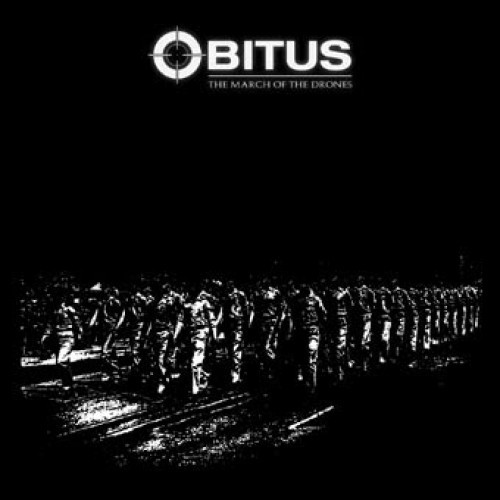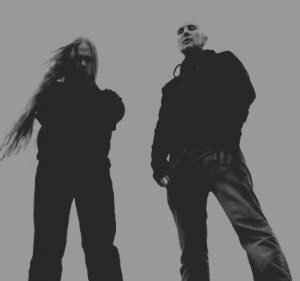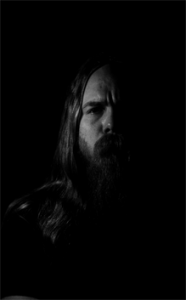
You probably thought we were finished with our mini-series on long songs — but no, we’re not finished. We have one more. Well, maybe two more, if we ever get around to the second one in between reviewing the flood of stunning new albums that were released the last couple of weeks. But at least one more, today.
In our previous installments of this series, we reviewed long songs by Hull, Agalloch, Akelei, and Radiance. Today, we’re writing about the longest song yet in this series: It’s an album-length song released last year by a black-metal band called Obitus. The album is divided into seven tracks, but that’s merely to facilitate jumping to favorite passages; Obitus intended the album to be heard as a single, seamless work, more than 47 minutes in length.
Now, in today’s frenetically-paced, attention-deficit-afflicted world, asking music fans to sit still for an entire album’s worth of non-stop listening is like trying to stop a surging river in its course with kind words. But in our heart-of-hearts, we know that unless we slow down and focus, at least every now and then, we will miss out on some valuable experiences. And so it is with the second full-length album from Obitus — The March of the Drones.
Obitus was formed in May 2000 by a couple of Swedes, Anders Ahlbäck (who plays all the instruments) and Johan Huldtgren (vocals and lyrics). Since then, they’ve produced a demo, a split, an EP, a debut full-length that was never released, and The March of the Drones. They took some risks creating an album-length song, testing the patience of a mostly impatient population of metalhead fans. But they clearly poured their hearts and souls into this work — and don’t be misled by the title: It refers to the album’s lyrical themes. Musically, The March of the Drones is a full-body immersion into a surging torrent of dark fire. (more after the jump . . . including a sample of the music)

At a high level, the song is primal black metal, relying on dense, repeating tremolo chords and a relentless drum attack, punctuated by swirling guitar leads that give the song its melodic core and execute the shifts in mood. The pace is an almost unrelenting charge from start to finish, with just enough tempo pauses and comparatively quiet interludes to let you catch your breath.
Although the stylistic shape of the song is old-school black metal, accented by Johan Huldtgren’s classically caustic vocals, the production isn’t given over to the typical muddiness of the music’s Nordic antecedents. Instead, the sound is sharp as a honed cleaver, crisp and clear, with the drums forward in the mix. Ahlbäck’s distorted guitars are dominant and dense, but you can hear what he’s doing. Only the bass is muffled in the background, more felt than heard for the most part, except for judiciously timed occasions when its thrumming steps forward to create variety.
A further word about the vocals: Huldtgren’s range from traditional Nordic throat-scraping shrieks to lower-register wolfish howls, but they’re almost entirely intelligible. He enunciates the bleak lyrics, which condemn the mindless, unquestioning, herd-like mentality of much of society (the “drones” of the album title) and the wasted lives consumed by drugs and violence. The point is driven home by spoken-word samples that mimic newscasts about fatalities of one sort or another.
The album-song is split into three parts, Summer (the first three tracks), Fall (the next two tracks), and Winter (the final two). But this really is one song — with slight variations in a unifying melodic theme
The first song segment (“Summer”) begins with an extended instrumental intro that consists of muffled guitar strumming that swells and ebbs in volume and that establishes a bleak atmosphere. It’s followed by an eruption of violent sound — Huldtgren begins to howl, a serrated guitar begins to riff, tremolo-picked chords begin to grind, and the drum attack launches in earnest. As the segment proceeds into the second “track”, the maelstrom of sound subsides, returning to the muffled guitar chords of the intro, and that attacking-and-subsiding trade-off continues over the balance of the segment.
 The first of the two “tracks” in the “Fall” segment (“Hypothesis”) is a purely instrumental passage filled with electronic pulses, flashes of drum-driven gunfire, and slow, reverberating guitar chords. Eventually, the drums begin to roll, transitioning the music into the second, long track (“Inconsequential”). Huldtgren’s raw vocals begin again, the blast beats erupt, and Ahlbäck’s guitar begins to saw through bone. Eventually, the pace slows, and the guitar chords peal in a variation of the melody that threaded its way through the “Summer” segment. Ahlbäck picks out an infectious arpeggio — the guitar echoing, rising, falling. The tempo slows and accelerates and slows again, with the lead guitar periodically bursting through the dense rhythm riffs to flash streamers of minor-key melody.
The first of the two “tracks” in the “Fall” segment (“Hypothesis”) is a purely instrumental passage filled with electronic pulses, flashes of drum-driven gunfire, and slow, reverberating guitar chords. Eventually, the drums begin to roll, transitioning the music into the second, long track (“Inconsequential”). Huldtgren’s raw vocals begin again, the blast beats erupt, and Ahlbäck’s guitar begins to saw through bone. Eventually, the pace slows, and the guitar chords peal in a variation of the melody that threaded its way through the “Summer” segment. Ahlbäck picks out an infectious arpeggio — the guitar echoing, rising, falling. The tempo slows and accelerates and slows again, with the lead guitar periodically bursting through the dense rhythm riffs to flash streamers of minor-key melody.
The sound fades, signaling the transition to the “Winter” segment, which begins with an electronic ambience that brings to mind a cold wind. A pulsing bit of electronica alternates with brief eruptions of vocals, guitar, and drums, and then the full sonic assault renews with unpent fury — headbanging riffs, flaring leads, a martial drum beat, and the bass stepping forward to ring like an anvil being struck.
A slight break in the pace marks the transition to the final “track” in the song, “The Drone Marches On”. There’s more icy shrieking, a new guitar riff exploring still more variations on the song’s dominant melodic theme, and dense waves of tremolo buzzing. After a near-stop pause and a period of soft guitar strumming and more news-cast samples, the lead guitar begins to blaze again in an extended instrumental passage — ringing melodic chords backed by methodical repeating drum fills and another moment of full-forward bass rhythms. And in the final minutes, the most melodic guitar lead on the album carried us away on a rising tide of emotion.
 In the end, this very long song hangs together as a coherent whole. It’s a completely immersive experience, a creative leavening of brutality with melody that is both atmospheric and cathartic. It should appeal to black-metal devotees who are willing to invest the time required to absorb the full sweep of its design.
In the end, this very long song hangs together as a coherent whole. It’s a completely immersive experience, a creative leavening of brutality with melody that is both atmospheric and cathartic. It should appeal to black-metal devotees who are willing to invest the time required to absorb the full sweep of its design.
Cutting out any one of these tracks for you to hear is inconsistent with the band’s blueprint for the album, but we can’t resist doing it anyway. Here’s the closing “track” (9:11 in length) from The March of the Drones:
For more info, visit the Obitus MySpace page here, or the band’s official web page. The album can be acquired in Europe via the New Sun Order web shop, in the U.S. from Forever Plagued Records or Red Stream Inc, and in Canada from Hypnotic Dirge. If you live in the U.S., you can also e-mail Johan Huldtgren at hell@obitus.org and he’ll tell you how to order a CD from the band via PayPal, which he can send from the U.S., where he is currently working.
And finally, you can also download portions of the Obitus discography for free, including three excerpts from March of the Drones as a single mp3 file, at this location.

Thanks for the review, just for clarification and credit where it’s due, we have two guests on this album: bass is performed by Mattias Nilsson (Grindnecks, Slaughtercult) and the death metal growls are by Fredrik Huldtgren (Canopy, Facing Death)
Thanks Johan — and I should have given those credits in the review since they’re clearly identified in the CD insert.
And I also should have said something about the CD insert — so I’ll say it here. It’s filled with stark, black-and-white photos of gears, abandoned buildings, marching soldiers, and includes eloquent lyrics that address the themes described in the review, as if in a debate or dialogue. It’s another example of why (in our humble opinion) there is still a place for CDs, album art, printed lyrics in our download-driven culture, and why we hope fans will continue to spend their money on them.
I prefer CD’s over downloads too. For that reason. But also because computers break and you’re likely to lose all your data. A CD you can break or lose, but you’re not likely to wreck your whole collection at once.
I didn’t want to admit it, but that’s another reason I get CDs whenever I can. I love computers, but I don’t trust them any more than I would trust a rabid dog. I have friends who think I’m a Neanderthal in this respect. I tell them that Neanderthals had bigger brains than homo sapiens.
They also had something else that was bigger…
Well, I’m trying to be modest. 🙂
Once again you pretty much nailed it, we didn’t print a 30 page booklet without reason. The lyrics are there for a reason, we want people to read them and think about them (you don’t have t agree with them, but read them and think about it). This is also why I tend to never explain the lyrics when asked in interviews, read them and think for yourself.
I thought the lyrics were brilliant, and the dialogue in them threads together from start to finish just as the music is integrated into a single song. I shouldn’t have been in such a hurry to finish the review in time for posting yesterday. I left out too many things I should have said! Optimist that I am, I wish the lyrics had ended with the defiance of “Endless Void” instead of the smug pronouncements of the other side in the debate in “The Drone Marches On”–
“The illusion of the dream is dead / you failed . . . As you always do / you cannot offer what we can / We can give eternal bliss / What have you to offer?”
haha yeah, the lyrics are more realistic and less optimistic.
I get that, and don’t disagree that they’re more realistic (mainstream society/culture is indeed massively fucked-up). (Sigh . . .)
Are those drums human-played or programmed? They just sound a bit too clean and fast for a human to be able to do this. I might be wrong though.
Great music in any case. Love the last third of the song!
Fair question, and one to which I don’t know the answer. Perhaps Johan will see it and let us know.
Programmed yes, too fast for a human, not really. Dark Funeral, Cryptopsy, Nile, or Hate Eternal would probably beg to differ. In my opinion there are quite a few albums featuring real drummers but where the drums are so heavily triggered that they actually sound faker than ours. I guess one could get into a whole philosophical discussion about whether an album featuring a human drummer but where the sounds are all triggered, and it’s digitally copy and pasted to avoid human imperfection is really any more real than purely programmed drums, but I digress.
I have this thought: Current technology makes it possible for two people to create an album like this one, which otherwise wouldn’t have been possible without recruiting other members. And even if that had happened, I suspect it would have been more difficult to achieve the intended design. You guys knew how you wanted the drums to sound, and what drum patterns you wanted to use to implement the musical ideas, and teaching those concepts to a human drummer (and he/she would have had to be a very good one), and having them executed in the way you envisioned, would have been difficult. No doubt, the album would have sounded different. So, this album is one example of why (at least for me), the availability of sophisticated sound-sample programming has been a welcome development. Just a thought . . .
Well to a certain extent yes, but on the one hand had we recruited a drummer we would probably have worked very hard with him to play it exactly like we envisioned it. That said it’s of course possible that he would have come with ideas for changing the drum patterns in ways that non-drummers would not have, thus resulting in a different sound. I remember an interview with Anaal Nathrakh where they said that the reason they never recruit a drummer for their albums is because they’ve already decided on exactly how they want it to sound so a drummer would just play what’s been written because that’s the sound they want.
That’s kind of what I was wanting to say. There are other really talented one- and two-person black-metal bands out there (Anaal Nathrakh, Darkthrone, Burzum, Xasthur), most of whom use one kind of technology assist or another to flesh out the instrumentation. That may derive in many cases from necessity, but it seems that faithful execution of the artistic vision can be just as big a factor.
I would like to add though, that to me the slight imperfections (not every beat having the exact same volume, timing, sound,etc.) gives music a more dynamic feel. For that reason I will always prefer a real drummer over programmed drums. However, I have to say that what you’ve done, Johan, sounds pretty damn good. It’s not the semi-electronic computer drums I’m used to hearing for programmed drums. The “sound color” is very realistic.
Absolutely, which is probably why most advanced drum programs today allow for both specific and random imperfections to be added. Thanks for the praise, we (Anders a lot more than me) spent a lot of time on the drums so we appreciate the feedback.
As Johan told us in his comment, and as we should have told you in our review, Johan’s brother Fredrik provided the death-metal growls on “The March of the Drones” — and if that name rings a bell with you, it may be because Fredrik is part of the awesome Canopy, whose latest album “Menhir” we reviewed at this location:
https://www.nocleansinging.com/2010/08/25/canopy-menhir/
Programmed drums aren’t a problem. Triggered drums are okay too, but that shouldn’t be used as a crutch to make up for sloppy and/or inconsistent playing. Having quality samples goes a long way and knowing how, when and where to apply them goes even further. I can’t even really tell and were it not for reading comments, I would probably be none the wiser at this point, although with a two man band it often falls to guests and/or programming to fill certain roles. Based on what I’ve heard, the drumming sounds real to me and within playable speeds – although something that could probably easily tire someone out. I think I need to play around with my audio settings again, since I’m having a hard time hearing the cymbals.
Making a song that’s this long is sometimes a gamble, but it seems like Obitus hasn’t fucked it up. Some songs can reuse musical elements, while others can play out more like a concept album. Both approaches work. 47 minutes made of the same things would probably get very boring, but hopefully there is some sense of connection in there somewhere, either with the lyrics or the music.
It’s going to the maybe list for now.
And when Johan mentioned Fredrik, I was tempted to make a leap of logic regarding possible relations between the two Huldtgrens, but Islander beat made the connection already. Still listening to Menhir quite a bit, plus I recently bought Will And Perception.
For what it’s worth I have no problems hearing the cymbals on my mp3s (EQ is turned off on my ipod so just listening to it raw).
In response to your second comment, this is a concept album, it plays out as such musically and lyrically, so you won’t have to look very hard for that connection that stitches it all together. That said it’s hard to claim that I’m in any way objective, so what is clear to me might not be as obvious to everybody else.
Obitus isn’t the only band where the cymbals seem subdued, but you’re among the bands where it seems more noticeable (or not, if you prefer). I’ll give it another go after messing around with a few settings, or trying in WMP instead of Winamp. I may have better luck with my iPod too. I just have get iTunes installed and find the dock for my Shuffle. I do need to listen some more anyway (and to the other stuff) so I can make up my mind whether it’s something I want to add to my collection.
Even with separate tracks, it’s really hard to isolate something to hear beforehand with something designed as single, continuous song and be able to represent all that it has to offer. I’ve heard edits of “Crimson” or “Light Of Day, Day Of Darkness” that do offer a glimpse, but there’s no way an edit or full track (for those split up) can really do an album length song justice. At least it’s not like the classic butchering of “In-A-Gadda-Da-Vida” that left out all the parts that make the song what it is.